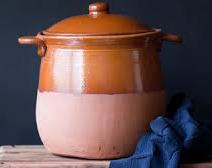 Ceramic is clay which has been fired at a temperature of more than 1,200 degrees. It is always waterproof.
Ceramic is clay which has been fired at a temperature of more than 1,200 degrees. It is always waterproof.
The oldest ceramic products are made about 8,000 years ago and have been found in China: Terracotta army with about 10,000 images between 0.5 and 1.8 meters.
There are three firing gradients: 900-1150⁰C. for porous pottery, stoneware between 1200-1400⁰C. where it is sintering and thereby impenetrable and porcelain 1400-1700⁰C. to become totally glazing.
At higher firing temperatures the material is each time harder, and the sound (on tap) higher.
Keramos = fired earth.
Terracotta (Italian: baked earth) is porous, unglazed red clay pottery. It is used for flower pots and inexpensive dishes. Alluvial clay, fed by seawater and rivers can only tolerate around 1000⁰C, and is used for bricks, tiles and flower pots.
Biscuit is clay that is fired only once without glaze in the kiln. Usually this is a semi-finished product: it is painted with enamel and then baked again (at higher temperatures).
It is also a pastry (s cake), or a cookie.
Pottery is formed and fired ceramic ware of clay, softer and less durable than porcelain, but much easier to make and cheaper. Due to the porosity, it must be glazed in order to be of practical use.
The 26,000 -year -old Moravian finding place Dolni Vestonice employs more than 6,750 fragments of burnt clay.
The earliest dated pottery from the Jomon culture in Japan is of 12,700 BP (Before Present). In the Amur in Siberia they found pieces of 13,000 years old.
Faience is a type of pottery glazed with an opaque white layer to make it appear Chinese porcelain. The clay is sometimes mixed with limestone or marl.
Chamotte is fired clay that is ground into flour or grains (up to 2 cm and more).
This cullet flour is added to clay in order to reduce shrinkage (tiles,...) and is mainly used in refractory firebricks.
Chamotte could be a corruption of the Italian ”scarmotti', burnt shards.
